Transform Your Small Bathroom with Skylight Ideas
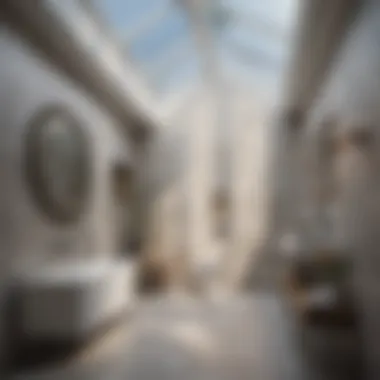
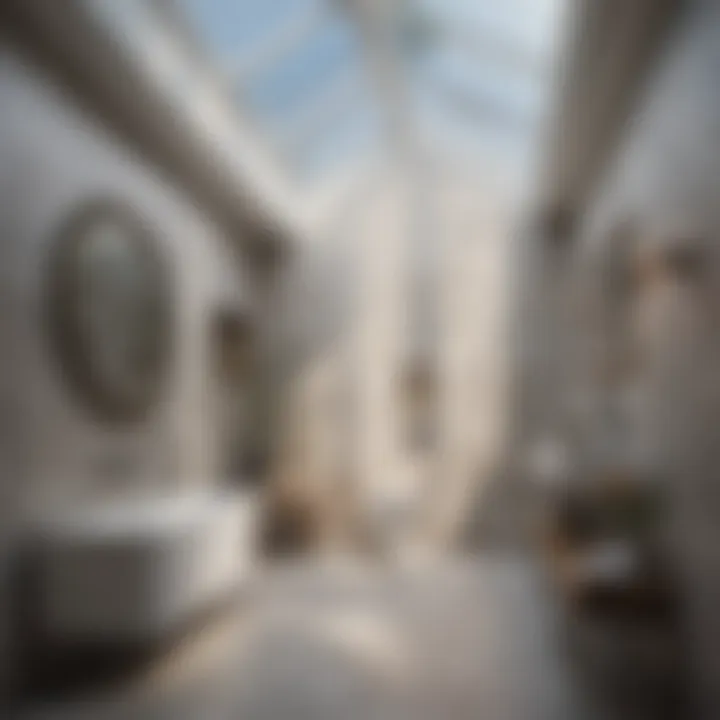
Intro
In the realm of modern home design, the smallest spaces often hold the most intriguing possibilities. Conspicuously absent from traditional design discussions, small bathrooms can be revitalized and transformed through one simple yet powerful feature: skylights. The integration of skylights not only fills the often cramped atmosphere with natural light but also adds a unique aesthetic appeal that can elevate the overall ambiance of the room.
When considering a bathroom update, the impact of light cannot be overstated; after all, a well-lit space can make all the difference in how a room feels. This article delves into transformative skylight ideas tailored for the small bathroom, examining how they fit into various design styles and practical considerations for homeowners and designers alike. So, let’s take a closer look at the myriad ways that skylights can breathe new life into these compact areas.
Design Inspirations
Trending Styles
There is no one-size-fits-all when it comes to choosing a skylight design. For many, selecting the right style hinges on the existing theme of the bathroom. Some popular choices include:
- Fixed Skylights: Perfect for minimalist designs, these overhead windows allow for maximum sunlight without any movable parts. Ideal for urban spaces where privacy is at a premium.
- Ventilated Skylights: These offer an added bonus, as they can be opened to let fresh air circulate, combating that damp bathroom smell. Worth considering for those who value both light and ventilation.
- Tubular Skylights: A brilliant option for particularly small bathrooms, these innovations channel natural light through a tube, making it possible to illuminate areas that otherwise might not receive much light.
Adapting the skylight type to your bathroom’s specific characteristics can significantly enhance both functionality and style. When you think about it, it’s a bit like fitting a key into a lock—if you have the right solution, it just clicks.
Color Palettes
Color plays a crucial role in the perception of space. Skylights can provide a wonderful backdrop for a wider array of colors. Consider the following color styles that harmonize well with natural light:
- Soft Neutrals: Shades like ivory or pale taupe create a warm, inviting atmosphere, allowing the light to reflect off the surfaces effortlessly.
- Cool Blues and Greens: These colors can evoke a sense of calm and tranquility, making the space feel more expansive while retaining that refreshing spa-like vibe.
- Contrasting Dark Tones: For those who prefer a bold look, pairing dark walls with strategic light sources such as skylights can create an intimate, cozy feel without sacrificing brightness.
Employing a savvy color palette that works alongside your skylight can create a cohesive and restful environment, making even the tiniest of bathrooms become a personal retreat.
"Natural light is the best disinfectant for the dreariness many small bathrooms face."
Practical Considerations
When thinking about installing a skylight in a small bathroom, several factors merit careful consideration:
- Installation Location: It’s essential to identify the areas that will benefit most from additional natural light while considering the existing roof structure.
- Sizing Limits: An oversized skylight may create glare or heat issues, so choosing the right size is fundamental to achieving that balance of light and comfort.
- Building Regulations: Always check your local building codes before installation—compliance ensures safety and longevity.
By keeping these practical considerations in mind, homeowners can make well-informed choices that will enhance both the aesthetics and functionality of their small bathrooms.
Understanding Skylights
In the realm of small bathroom design, skylights have emerged as a powerful tool for transformation. They not only serve as a source of natural light but also enhance the overall aesthetic appeal while improving ventilation. Understanding skylights means recognizing their potential to bridge the gap between your indoor space and the outdoors, creating an ambiance that is airy and welcoming. This section delves into what skylights are all about and the significance of incorporating them into compact bathroom designs.
Defining Skylights
Skylights are essentially windows installed in the roof or ceiling of a structure, allowing sunlight to flood into the space below. Unlike conventional windows, which typically look out onto a wall or landscape, skylights open up the view to the sky. This unique positioning enables homeowners to harness natural light effectively, making small bathrooms feel more expansive and less confined.
The core definition revolves around two main elements: placement and purpose. Proper placement can maximize both the influx of light and the ability to ventilate. They can be fixed, where they stay in place, or operable, allowing for manual or automatic opening. Regardless of the type, the primary role of skylights is to illuminate and ventilate compact spaces, making them an invaluable addition when every square inch counts.
Types of Skylights
When considering skylights for small bathrooms, it’s crucial to familiarize oneself with the different types available:
- Fixed Skylights: These are stationary and designed solely to bring in light. They don’t open, which makes them easier to install but limits airflow.
- Ventilated Skylights: As the name suggests, these can be opened for airflow. Often equipped with remote controls, they're perfect for enhancing bathroom ventilation along with natural light.
- Tubular Skylights: For those dealing with tight spaces, tubular skylights are a compact option. They channel sunlight from the roof down through a reflective tube, allowing light to enter smaller areas without taking up much roof space.
- Dome Skylights: These skylights feature a curved design, providing both aesthetic appeal and an efficient way to deflect rain and snow. They can be great in areas with high precipitation.
- Custom Skylights: Tailored to individual needs, these allow for creative freedom in design, which can be particularly beneficial in uniquely shaped bathrooms.
By grasping the various types of skylights, homeowners can make informed choices regarding which option best suits their needs, considering factors such as space efficiency, natural light preferences, and ventilation requirements.
"Incorporating skylights is not just about light; it's about designing an environment that feels expansive and refreshing."
Benefits of Skylights in Small Bathrooms
Skylights can breathe life into compact bathroom spaces, transforming an often cramped environment into a sanctuary of light and air. Far beyond mere aesthetic appeal, the benefits of installing a skylight stretch into various practical realms, making them an excellent addition for homeowners and designers alike. Let’s explore the advantages that skylights bring to small bathrooms, centering on natural light enhancement, ventilation improvements, and an overall perception of expanded space.
Natural Light Enhancement
When you introduce a skylight into a small bathroom, the most immediate and striking benefit is the flood of natural light it welcomes. Imagine stepping into a bathroom that feels bright and open instead of dark and confined. Natural light not only brightens the room but also has the effect of improving mood, which is crucial in a space where relaxation should reign.
Unlike typical windows, skylights are positioned on the roof, allowing light to penetrate deeper within the room, often reaching places where wall-mounted windows fail. This lighting boost cuts down on the dependency for artificial lights during the day, leading to a more sustainable and cost-effective approach to lighting.
Some homeowners prefer to opt for larger fixed skylights for maximum illumination, while others might choose smaller tubular skylights that still pack a punch in terms of light. Either way, adding a skylight can significantly lighten up a small toilet or bathing area, making it feel welcoming.
Ventilation Improvements
Ventilation is another critical aspect where skylights shine brightly in small bathrooms. With moisture-prone spaces, it’s paramount to control humidity levels and prevent issues like mold and mildew. This is where ventilated skylights show their worth.
A skylight that can open allows fresh air to circulate, reducing steam and odors after a hot bath or shower. The act of letting in fresh air not only alleviates dampness but can also improve overall air quality. For example, a simple flick of a switch or the pull of a cord can allow excess moisture to escape, making those post-bath moments far more pleasant. This is especially useful in smaller bathrooms where air might feel stagnant or heavy.
Perceived Space Expansion
Perhaps one of the most appealing benefits of incorporating a skylight into a small bathroom is the illusion of a larger space. Although the physical dimensions of the bathroom remain unchanged, the influx of natural light and open sky above creates a perception of expansion.
By illuminating the room with daylight, the walls appear to recede, and the ceiling seems to soar higher. This gives the sensation of being in a more expansive space, counteracting the feeling of constriction that can often plague small bathrooms.
"A well-placed skylight can turn a tight spot into a bright escape."
In essence, the right skylight can alter the atmosphere, inviting not only light but a sense of freedom and airy openness. When homeowners feel comfortable and spacious in their bathroom, it greatly enhances their daily experience.
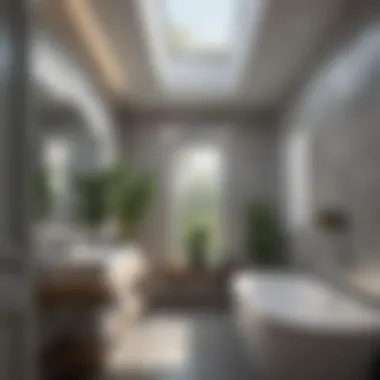
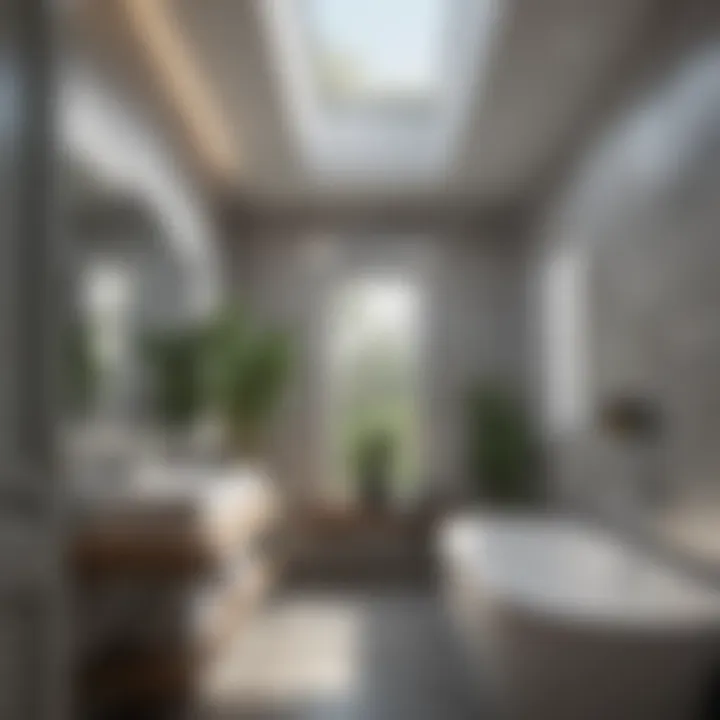
In summary, installing skylights in small bathrooms can yield significant benefits that go beyond mere decoration. Natural light enhances the atmosphere, while proper ventilation keeps the air fresh, and the perception of greater space helps alleviate the cramped feeling often experienced in smaller environments. Investing in a skylight is not just a home improvement; it's a means to elevate both comfort and aesthetics.
Design Considerations
In the realm of small bathroom skylights, the elements of design are not mere aesthetics but crucial components that can significantly impact functionality, comfort, and overall ambiance. Making well-informed decisions in this space involves careful consideration of size and placement, style compatibility, and privacy concerns. Each of these factors intertwines to create a cohesive environment that elevates the everyday bathing experience.
Size and Placement
When contemplating the right skylight for your small bathroom, size isn't just a number—it's a determining factor for how natural light will flood the space. A snug bathroom should not feel cramped or overwhelmed by an overly large skylight that can create unwanted heat buildup. Conversely, a small skylight might not channel enough light into shadowy corners, leaving the space feeling dim and uninviting.
Placement is equally vital. Installing a skylight centered above the bathtub can create a delightful viewing area for star-gazing while soaking, but if it aligns too closely with neighbor's windows, complications regarding privacy might arise. Generally, placing the skylight towards the higher part of the wall or near the roof can help maximize daylight and create an illusion of height. A good rule of thumb is to allow at least 10-20% of the floor area to be covered by natural light to create a balanced atmosphere.
Style Compatibility
Beauty is in the eye of the beholder, but when it comes to incorporating a skylight, the design must harmonize with existing decor. Consider your bathroom's overall theme—be it modern, vintage, or minimalist. A sleek, modern skylight with clean lines might seamlessly blend into a contemporary setting, while a rustic wooden-framed skylight could enhance a farmhouse-style bathroom.
Key Points:
- Match materials and finishes of the skylight frame with that of the fixtures and cabinetry.
- Choose glass types that complement other windows in the room, maintaining a cohesive look.
- Evaluate the color schemes to ensure the skylight does not clash with the walls or furnishings.
Not only does style compatibility enhance the visual appeal, but it can also contribute to value retention when you decide to sell. A bathroom that flows visually can significantly lift the perceived worth of your home.
Privacy Concerns
In bathrooms, privacy reigns supreme. The last thing anyone wants is for their relaxing soak to be interrupted by curious neighbors or passersby. Luckily, there are innovative ways to ensure privacy without sacrificing natural light.
Using frosted or tinted glass for the skylight can obscure views while still allowing luminous rays to beam through. Another approach is to integrate solar shades that can be effortlessly adjusted depending on time of day and privacy needs.
Consider the following options for maintaining privacy:
- Frosted glass: Provides light diffusion without visibility.
- Translucent panels: Ideal for a stylish yet safe look.
- Smart glass technology: Switch from clear to opaque at the push of a button, combining luxury with utility.
Balancing privacy with natural light can transform the mood of the bathroom, fostering a serene atmosphere perfect for unwinding after a long day.
Skylight Styles for Small Bathrooms
When it comes to small bathrooms, every design decision counts. Skylights serve not only as functional elements but also as unique design features that can transform a cramped space into a refuge of light and air. The style of skylight selected can significantly influence both the aesthetic and utility of a bathroom.
With an array of choices available, it’s worthwhile to consider how each style aligns with the bathroom's overall layout and decor. Choosing the right skylight involves understanding its impact on natural lighting, warmth, and ventilation. It can also enhance the sense of space, crucial for small areas.
Fixed Skylights
Fixed skylights bring a direct infusion of sunshine into your bathroom, making it feel larger and more open. They are non-operable, which means they don’t vent but do provide uninterrupted daylight during the day. The most significant advantage of fixed skylights is their simplicity; they’re often easier to install and maintain compared to other styles that function mechanically.
"Natural light can make a home feel alive, especially in compact spaces where light is scarce."
When you opt for a fixed skylight, consider its placement. Ideally, these should be positioned strategically to maximize daylight when the sun is at its peak without creating glare or heat buildup. They can be framed in various materials from wood to aluminum, allowing for personalization that matches your bathroom decor.
Ventilated Skylights
If you’re looking to blend natural light with airflow, ventilated skylights are your best bet. These skylights can be opened either manually or electronically, allowing fresh air to flow in as sunlight pours through. The benefits extend beyond mere aesthetics; good ventilation helps reduce moisture build-up, which is a common issue in bathrooms.
Considerations for Ventilated Skylights:
- Motorized Options: Easy to operate, especially those fitted with rain sensors that automate closing when it rains.
- Location, Location: Position is key; ideally placed above showers or tubs to help with dampness.
- Design Compatibility: They come in various designs including pivoting and sliding options, so matching with your bathroom style should be straightforward.
Tubular Skylights
Tubular skylights present an innovative option for those who want natural light without needing a large area. These operate with a simple design: a small dome installed on the roof, which captures sunlight and reflects it down through a tube into the bathroom.
Advantages of Tubular Skylights:
- Versatility: Ideal for locations where a conventional skylight isn’t feasible due to space or layout.
- Energy Efficiency: Less heat loss compared to larger skylights, and they can capture light from a wider area.
- Installation Flexibility: They can be routed around obstacles, making them an option for more complicated layouts.
The choice of skylight style will ultimately depend on various factors including your aesthetic preference, bathroom layout, and how much natural light or ventilation you desire. Making an informed choice can lead to a beautifully lit space that enhances your bathing experience, all while keeping energy efficiency in mind.
Whether going for fixed, ventilated, or tubular options, each style brings unique attributes to the table. The goal remains clear: to brighten up small bathrooms and make them more inviting.
Materials Used in Skylight Construction
Choosing the right materials for skylights in small bathrooms is crucial for both functionality and aesthetics. The materials influence not only the amount of natural light that enters the space but also how effectively the skylights can handle different weather conditions, thus providing durability and energy efficiency.
When considering skylight installation, it's important to weigh the pros and cons of various materials. The right material can enhance the overall design and ensure long-term satisfaction. Here’s a closer look at two primary materials used in skylight construction:
Glass Options
Glass is often the go-to choice for skylights due to its clarity and the natural light it allows into a room. There are different types of glass available for skylights, each offering unique advantages:
- Tempered Glass: This type is treated with heat to strengthen it, making it more shatter-resistant. It’s a great option for safety, especially in family bathrooms.
- Laminated Glass: This is produced by sandwiching a layer of plastic between two sheets of glass. If shattered, it holds together rather than creating sharp shards, enhancing safety further.
- Low-E Glass: Short for low-emissivity glass, it features a coating that reflects heat while still allowing light in. This helps maintain a comfortable temperature in the bathroom, reducing energy costs.
Overall, glass skylights offer both elegance and practicality. However, they require regular cleaning to maintain clarity and maximum light transmission. A great way to keep them spotless is by using a mixture of vinegar and water.
"Choosing the right glass can make all the difference in energy efficiency and aesthetic appeal."
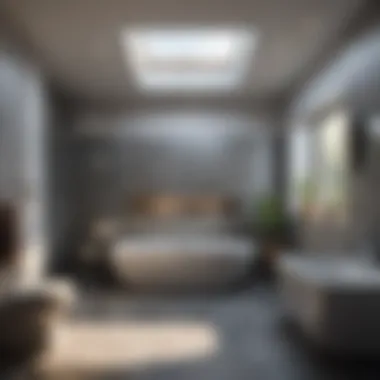
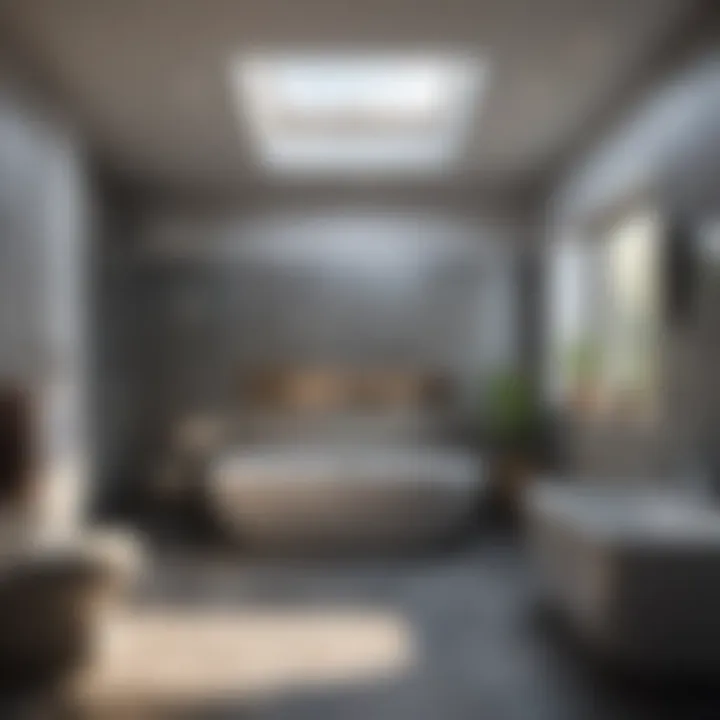
Polycarbonate Materials
Polycarbonate skylights have gained traction as a lightweight, resilient alternative to glass. Made from a strong plastic, polycarbonate offers several noteworthy benefits:
- Impact Resistance: Unlike glass, polycarbonate is virtually unbreakable, making it a great choice for areas susceptible to harsh weather conditions.
- Thermal Insulation: Polycarbonate can provide better insulation than traditional glass options, helping to keep your small bathroom warm in winter and cool in summer.
- Cost-Effectiveness: Generally, polycarbonate skylights are less expensive than glass options. This affordability can make them an appealing choice for budget-conscious homeowners.
However, polycarbonate may yellow or become cloudy over time due to UV exposure, so look for products with UV protection to prolong clarity and performance.
When considering materials for your skylight, it’s essential to evaluate factors like climate, budget, and personal aesthetic preferences. Overall, both glass and polycarbonate have their place in skylight construction, particularly in the intimate atmosphere of a small bathroom.
Installation Considerations
When it comes to installing a skylight in a small bathroom, there are several key factors to consider. Unlike standard windows, skylights present unique challenges and opportunities that can greatly affect the functionality and aesthetics of the room. This section walks through the crux of skylight installation, highlighting its importance in enhancing light and space while ensuring safety and practicality.
Installing a skylight can make a bathroom feel more open and airy, creating a pleasant ambiance that artificial lighting just can't replicate. With the right installation strategy, a skylight can optimize natural light, mitigate moisture issues, and harmonize with existing spaces. However, before hopping into the installation process, understanding some nuances is key to a successful outcome.
Professional vs. DIY Installation
Professional installation can offer peace of mind. Experts have the skills to navigate local building codes, deal with structural supports, and ensure proper sealing to prevent moisture infiltration. They know how to assess the ideal placement, taking into account the roof pitch, sunlight patterns, and potential obstructions, such as overhanging branches.
However, if you're a hands-on type of homeowner, a DIY installation can be awfully tempting. For those with a solid understanding of home improvement, installing a skylight yourself can be a fulfilling project. It can save money and offer a sense of accomplishment. Just keep in mind, you’ll need the right tools, knowledge about roofing, and probably some extra pairs of hands. Proper planning is critical, and it's worth investing extra time to ensure everything aligns with local safety standards and weatherproofing.
"Whether you enlist professional help or tackle the job alone, a thought-out installation plan is crucial to capture all the benefits of your new skylight."
Cost Factors
Budgeting for a skylight installation means considering several dimensions. Prices can range significantly based on skylight type, materials, and labor costs, whether you get outside help or go the DIY route. Here are some cost factors to consider:
- Type of Skylight: Fixed skylights tend to be cheaper than ventilated ones. Tubular skylights can also offer great light at a lower cost compared to larger glass options.
- Materials: Glass skylights usually come at a higher price point, especially if you're opting for energy-efficient or tempered glass. Polycarbonate options, while less expensive, may not offer the same level of durability or insulation.
- Installation Fees: If you opt for professional installation, labor costs can vary based on region, expertise, and complexity of the project.
- Hidden Costs: Don’t forget about potential necessary structural reinforcements or alterations to the roof. These can escalate your budget quickly, so always plan for a little wiggle room.
In summary, the choice between professional installation and DIY hinges on your comfort level with home improvement tasks, while cost factors can heavily influence how much you're willing to invest in your skylight adventure. Ensuring that your skylight integrates well with the existing design will not only beautify your space but also enhance its overall functionality.
Maintenance and Care
Taking care of your skylights goes beyond aesthetics; it's about ensuring long-lasting functionality and keeping the space cozy and pleasant. Just like a well-tended garden flourishes, a bit of care for your skylights can enhance their performance and longevity, all while providing the much-needed natural light that small bathrooms can sometimes lack.
Cleaning Skylights
Cleanliness is next to godliness, as the saying goes, and this holds true for skylights as well. Over time, dirt and grime can accumulate on the glass, impacting the light quality and views. Here’s a straightforward approach to keeping that glass sparkling:
- Choose the Right Time: The best time to clean is during a cloudy day. Direct sunlight can dry cleaning solutions too quickly, leaving streaks behind.
- Use Mild Detergent: Mix some dish soap or a gentle detergent with lukewarm water. Avoid harsh chemicals that might damage the frames or seals.
- Soft Cloth or Squeegee: A microfiber cloth is perfect for wiping down glass surfaces. If you have an extension squeegee, it can make it easier to reach those higher skylights.
- Avoid Abrasives: Steer clear of scouring pads that could scratch the glass.
- Rinse and Dry: Make sure to rinse away any detergent residue and dry thoroughly to prevent water spots.
This process can keep your skylights clear and functional. After all, nothing ruins that lovely natural light like a dirty pane of glass!
Checking for Leaks
Water leaks can be a homeowner’s worst nightmare, especially in a bathroom where moisture already poses a challenge. Regular checks can help you avoid costly repairs and maintain the integrity of your skylight.
Here are some simple yet effective steps:
- Visual Inspection: Keep an eye out for cracks in the glass, especially around the edges. Check the seals where the skylight meets the roof. Any visible damage should be addressed promptly.
- Look for Water Stains: Inspect the ceiling and walls around the skylight for any signs of water stains or discoloration. If you notice any, it might be a signal that a leak is already present.
- Conduct a Water Test: If all seems well but you’re still unsure, you can perform a controlled test. Use a hose to gently spray water around the skylight, and observe if any moisture appears indoors afterward.
- Consult a Professional: If you uncover leaks or if you're unsure how to locate the source, it’s wise to consult a professional. They can provide expertise to tackle issues effectively.
"An ounce of prevention is worth a pound of cure" – this couldn’t be truer when it comes to maintaining your skylights. Staying proactive in checking for leaks can spare you from future headaches.
A little bit of attention on maintenance can go a long way toward preserving that airy, bright feel you've created in your small bathroom. After all, who wants to swap the sunlit spa vibe for moldy ceilings?
Integrating Skylights with Existing Design
When it comes to small bathrooms, integrating skylights with the existing design is not just a preference—it's a necessity for achieving a harmonious balance between functionality and aesthetic appeal. A well-placed skylight can elevate the bathroom’s ambiance, making it feel larger and more inviting. The beauty of installing a skylight lies in its ability to introduce natural light, but to truly maximize its benefits, careful consideration must be given to how it meshes with the rest of the space.
Color Schemes
Color is a powerful tool in any design endeavor. When incorporating skylights, it’s vital to choose color schemes that complement the influx of natural light. Light, airy colors like soft whites, pale blues, or gentle greens can enhance the reflection of sunlight, creating an open, breezy feel in the bathroom. Paired with the shadows cast by skylight angles, these colors can play off each other remarkably.
On the flip side, darker hues can introduce drama but may absorb light rather than reflect it. If the bathroom is already limited in light due to space constraints, opting for mid-tones can offer a balanced approach. For instance, a medium gray could serve as a sophisticated backdrop, while still allowing light to brighten the space.
It's also helpful to consider the color of the materials around the skylight itself—think frames, shades, or filters. A well-matched color palette can turn a functional element into a stunning focal point.
Bathroom Fixtures Coordination
The key to a seamless design is, unsurprisingly, coordination. When selecting bathroom fixtures, take into account the style of your skylight. If you’ve chosen a modern skylight, outfitting the bathroom with contemporary fixtures—such as sleek faucets or minimalist cabinetry—will unify the space. However, vintage fixtures paired with a traditional skylight can evoke a charming, cozy atmosphere.
Furthermore, consider materials: a stainless-steel showerhead can create a dynamic contrast against a wooden frame skylight, for example, complementing the natural details with a modern touch. Not to mention, keeping the aesthetic cohesive will ensure your bathroom doesn’t feel disjointed. Such choices not only amplify visual appeal but enhance the overall comfort and functionality of the space.
Floor and Wall Treatments
Finally, let’s talk about floors and walls—these large surfaces can significantly impact your bathroom's design. When integrating a skylight, the treatment of these surfaces should harmonize with the light. For instance, glossy tiles can reflect light beautifully, while matte finishes tend to absorb it.
In terms of wall treatments, consider using lighter-colored paint or wallpaper that allows light to bounce around the room. Additionally, decorative elements like wainscoting can create a layered effect, accentuating the height provided by the skylight. This layered look not only draws the eye upward but also generates an illusion of spaciousness, key for smaller bathrooms.
"Integrating Skylights not just illuminates your space but also enriches its design language."
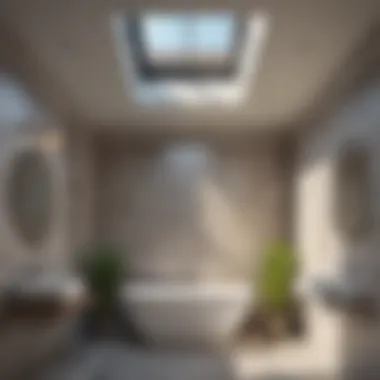
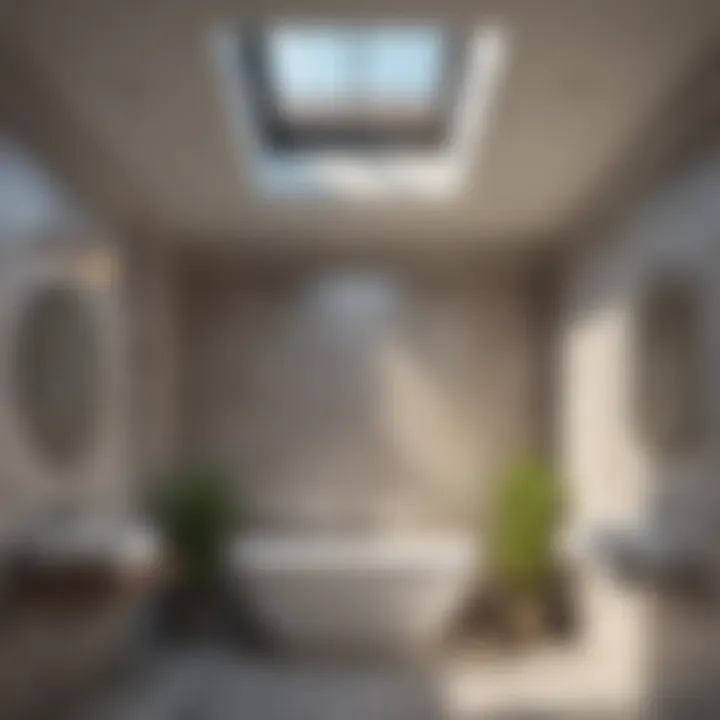
Overall, the integration of skylights with an existing design in small bathrooms sets the stage for a cohesive, vibrant space. Proper attention to color schemes, fixture coordination, and treatment of surfaces can transform a typical bathroom into an extraordinary retreat.
Environmental and Energy Efficiency Factors
Sustainability Practices
Implementing skylights in small bathrooms isn't just about looking good; it's also about embracing sustainability. Skylights can reduce the reliance on artificial lighting and, therefore, decrease energy use in homes. Here's how:
- Natural Illumination: By allowing daylight to flood the space, they minimize the need for overhead lights during the day. This not only assists in lowering electricity bills but also reduces the overall carbon footprint of the household.
- Materials Matter: Many modern skylights come with energy-efficient materials like low-E glass, which reflects heat while allowing natural light in. This choice helps control indoor temperatures. It’s crucial to ensure that these materials are sourced sustainably, reflecting a commitment to eco-friendly practices.
- Water Management: Integrating a skylight might require alterations to your bathroom’s architecture. This can be an ideal time to improve drainage systems to prevent water stagnation. Sustainable practices should include proper rainwater management systems that direct water away from the home’s foundation and into gardens or rain barrels.
"Incorporating sustainable skylights isn’t just a home improvement; it’s an investment in the planet's future."
Energy Savings
In addition to enhancing the bathroom through natural light, skylights can offer notable energy savings. More specifically:
- Reduced Heating and Cooling Costs: A well-placed skylight can help regulate indoor temperature. In winter, sunlight warms the bathroom, reducing heating needs. Conversely, in summer, models with ventilation can help expel warm air, subsequently lowering the demand for air conditioning.
- Long-Term Efficiency: While the initial cost of installing skylights can vary, investing in high-quality, energy-efficient skylights can yield significant savings over time. Homeowners should consider life-cycle assessments to gauge potential energy savings in relation to upfront costs.
- Tax Incentives: Depending on the region, certain energy-efficient installations may qualify for tax credits or rebates. This could further offset the initial investment of incorporating skylights.
The significance of environmental and energy efficiency factors in a small bathroom skylight installation cannot be neglected. Making informed decisions not only enhances your living space but also positively impacts the planet and your wallet.
Case Studies and Real-World Examples
In the realm of small bathroom design, case studies serve as illuminating pillars that shed light on how skylights can fundamentally enhance functionality and aesthetics. These real-world examples not only provide a visual reference but also underscore the practical benefits and considerations of integrating skylights into compact spaces. By examining successful installations, we can unravel key themes ranging from design adaptability to material choice, all specific to small bathrooms.
Successful Skylight Installations
The concept of putting a skylight in a small bathroom might seem like an ambitious endeavor, but countless homeowners have successfully transformed their confined spaces. For instance, consider a small townhouse in an urban setting where the primary bathroom felt dark and cramped. The owners decided to install a fixed skylight above the shower area. This simple addition allowed natural light to flood the space, creating a warm and inviting atmosphere.
- Design Flexibility: The skylight was framed neatly within the existing structure, ensuring that it harmoniously fit into the current design without overwhelming the small area.
- Material Choice: A double-glazed glass unit was selected for energy efficiency, ensuring that heat escape was minimized while maximizing daylight.
- Installation Insight: A professional contractor handled the installation, ensuring that the roof pitch and waterproofing were correctly addressed to prevent any long-term issues.
Such successful installations illustrate the immense potential of skylights in small bathrooms. They can transform spaces that might have previously felt confining into areas brimming with light and openness.
Before and After Transformations
One striking aspect of skylight integration is the dramatic change it can bring to a space. Take, for instance, a quaint cottage-style bathroom that had seen better days. It was characterized by inadequate lighting and outdated decor. After the owners added a tubular skylight, the transformation was remarkable.
- Before: The previous dark and dingy feeling was palpable, and with missing vibrant colors from decor, it lacked personality.
- After: With sunlight streaming through the new skylight, the once muted tiles sprang to life. Colors became more visible, and the entire aura evolved into one of serenity and relaxation.
Homeowners reported improved moods and an enhanced bathing experience, underlining a critical benefit of incorporating natural light into small spaces. In many ways, the skylight served as a catalyst for further home improvements, driving the owners to invest in new fixtures and better wall treatments as they restored their bathroom.
These examples exemplify how skylights can go beyond mere functionality. They encourage a fresh perspective on design while elevating the overall bathroom experience, making the most of limited space. The discussions surrounding these case studies remind us there's always room for innovation, even in the smallest of bathrooms.
Innovative Lighting Solutions
The integration of lighting in small bathrooms plays an indispensable role in optimizing both function and aesthetics. As our living spaces evolve, the notion of innovative lighting solutions continues to gain traction. For small bathrooms, this means embracing options that marry efficiency and elegance. Well-placed lights can enhance the natural light provided by skylights while also focusing on essential areas when needed.
Complementing Natural Light
Using skylights as a primary source of natural light is a great starting point, but it creates a new layer of complexity in lighting design. The unieque challenge lies in balancing the daylight with artificial sources. Consider the time of day: when the sun dips below the horizon, artificial lights need to step up. Here’s where placement comes into play.
- Position fixtures at critical spots where shadows may cast most heavily, such as around mirrors or above sinks.
- Opt for warm light bulbs that mimic natural daylight, ensuring a flattering glow that doesn't create an uninvitingly harsh contrast with the sunlight during the day.
Furthermore, wall sconces can be a charming addition to any bathroom. They not only serve a functional purpose by providing illumination, but they also enhance the style of the space.
Consider combining soft white LED lights with dimmer switches to further emphasize the soft tranquility that comes with natural light.
Layered Lighting Techniques
Layered lighting is like creating a symphony, where each type contributes to the overall experience. Think of it as building your lighting strategy around three types of lighting: ambient, task, and accent. Using all three effectively will make a small bathroom feel cozy and efficient.
- Ambient Lighting
- Task Lighting
- Accent Lighting
- This should be your main source. If you have a skylight, let that become part of your ambient ambiance during the day. At night, ceiling fixtures with broader radiation can help fill the void left by the sun.
- Direct attention to specific areas, like above the vanity mirror. Adjustable spotlights, for example, can be directed to where needed, enhancing visibility without overwhelming the senses.
- Integrate accent lighting to add depth. Choose a backlit mirror or illuminated shelves for a refined look. It draws the eye to particular features in the room, making the bathroom feel more spacious than it is.
In designing innovative lighting solutions, remember that each layer should harmonize with the next. The interplay of light will not only brighten a space but can also create an emotional connection, transforming the bathroom experience.
Closure and Future Perspectives
In wrapping up our exploration into skylights in small bathrooms, it becomes clear that these architectural features do much more than merely brighten a space; they reshape the entire experience of the bathroom. Investing in skylights can yield significant long-term value, entwining functionality with aesthetics to craft an environment that enhances well-being. As homeowners and designers alike contemplate options for maximizing space and light, skylights emerge as a compelling solution that embodies both practicality and beauty.
Long-Term Value of Skylights
When evaluating the long-term value of skylights, several aspects come to the forefront:
- Increased Property Value: Homes with well-designed skylights often see an uptick in market value. Skylights aren’t just a decorative addition; they appeal strongly to prospective buyers who appreciate modern features in a home layout.
- Energy Efficiency: Although initially an investment, skylights can lower energy bills by reducing the need for artificial lighting during daytime hours. Modern options come with energy-efficient glazing, which contributes to better insulation and maintains comfortable temperatures.
- Enhanced Quality of Life: The introduction of natural light into small bathrooms not only boosts mood but also positively affects one’s mental health. Natural light can help in regulating circadian rhythms, leading to improved sleep patterns and overall well-being.
Thus, the investment in skylights transcends mere functionality; it embodies a vision for healthier living spaces that contribute to the overall joy of home life.
Evolving Trends in Bathroom Design
As we venture forward, it’s impossible to overlook the seismic shifts occurring in bathroom design. Here are notable trends shaping the future of skylights and bathroom aesthetics:
- Sustainable Designs: Homeowners are increasingly leaning towards eco-friendly solutions. Skylights made from sustainable materials and designed to minimize energy consumption fit seamlessly into these more conscientious home improvement styles.
- Smart Technology Integration: With advancements in technology, skylights are becoming smarter. Features such as automated shades, sensors that adjust lighting based on time of day, and even ventilation systems that open when humidity rises are gathering traction.
- Hybrid Spaces: There’s a growing trend to design bathrooms that pair function with leisure, transforming them into sanctuaries. Skylights play a crucial role in this evolution by providing ample natural light, which is vital for creating calm and inviting atmospheres.
In summary, the future of skylight design and bathroom integration shines brightly, offering innovative approaches that not only address practical concerns but also enhance the emotional well-being of inhabitants. The commitment to marrying functionality with aesthetic appeal reinforces skylights as a worthy consideration in small bathroom designs.



